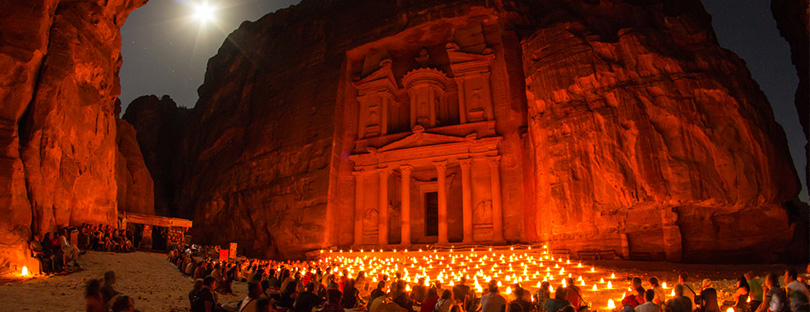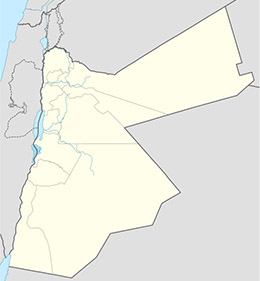Jordan
- The name Jordan derives from Arabic and other Semitic languages and has many meanings; Ancient Arabic meaning “Slope", the Aramaic meaning "down-flowing" or "one who descends". King Abdallah I - established the Emirate of Transjordan after World War I.
- Jordan considered as the crossroads of the Middle East, Jordan and Palestine have served as a strategic connection in Asia, Africa and Europe. The geography of Jordan has given it an important role to play as a conduit for trade and communications, connecting east and west, north and south, It is very rich in the historical and religious sites from “Umm Qays” North to “Petra” South.
Mount Nebo
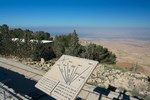 Mount Nebo is one of the most holy sites of Jordan, located 10 km west of the Roman Byzantine town of Madaba. It is the site where Moses went up from the fields of Moab to the Mount of Nebo and where he was buried. From the top of this site, which is about 800 m above the sea level, you can see a very clear view of Jerusalem and Bethlehem .In the year 1933 the excavations at Syagha, the highest point of Mount Nebo, several archeological campaigns began under the supervision and direction of the Franciscan Fathers in Jerusalem; they discovered the Basilica and a big monastery. Visiting the Sanctuary at Nebo, the memorial of Moses, his death and burial place, considered one of the Holy sites since early Christian times. Visitors will be inspired by a biblical feeling during their visit to the site.
Mount Nebo is one of the most holy sites of Jordan, located 10 km west of the Roman Byzantine town of Madaba. It is the site where Moses went up from the fields of Moab to the Mount of Nebo and where he was buried. From the top of this site, which is about 800 m above the sea level, you can see a very clear view of Jerusalem and Bethlehem .In the year 1933 the excavations at Syagha, the highest point of Mount Nebo, several archeological campaigns began under the supervision and direction of the Franciscan Fathers in Jerusalem; they discovered the Basilica and a big monastery. Visiting the Sanctuary at Nebo, the memorial of Moses, his death and burial place, considered one of the Holy sites since early Christian times. Visitors will be inspired by a biblical feeling during their visit to the site.
Madaba
 Madaba is the capital city of Madaba Governorate in central Jordan, with a population of about 65,000. It is located 30 kilometers south west of the capital Amman. The first evidence for a Christian community in the city, with its own bishop, is found in the Acts of the Council of Chalcedon in 451.
Madaba is the capital city of Madaba Governorate in central Jordan, with a population of about 65,000. It is located 30 kilometers south west of the capital Amman. The first evidence for a Christian community in the city, with its own bishop, is found in the Acts of the Council of Chalcedon in 451. - The Madaba Mosaic Map, with two million pieces of colored stone, is a map of the region dating from the 6th century and preserved on the floor of the Greek Orthodox Basilica of Saint George. The mosaic represents the whole biblical area, it is deemed to be one of the best topographical representations of the Biblical Lands. This map is one key in developing scholarly knowledge about the physical layout of Jerusalem after its destruction and rebuilding in 70 AD.
Amman Capital
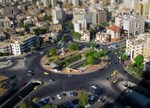 It is the Modern capital of Hashemite Kingdom of Jordan and was known as Rabbath-Amon the capital of Ammonites 1200 BC. Recent excavations have uncovered home believed to have been built during the stone age. During the Greco-Roman time and specifically in the third century BC this city was renamed Philadelphia as a part of Decapolis League.
It is the Modern capital of Hashemite Kingdom of Jordan and was known as Rabbath-Amon the capital of Ammonites 1200 BC. Recent excavations have uncovered home believed to have been built during the stone age. During the Greco-Roman time and specifically in the third century BC this city was renamed Philadelphia as a part of Decapolis League. - The Modern history of Amman began in 19th Century and as from the Great Arab Revolt Prince Abdallah Ibn El-Hussein the founder of the Hashemite Kingdom of Jordan made Amman his Capital in 1921.
Petra
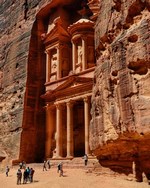 It is located around 260 KM south of Amman on the way to the Red Sea “Aqaba” It was the legacy of Nabataeas , an Arab people who settled in the south of Jordan. The rock-carved rose-red city of Petra is full of mysterious charm which attracts the sight of every person who visit the site. It includes tombs, buildings, baths, funerary caves, temples and arched gateways, whatever we give explanation about such historical site we do not give the Nabataeas their rights.
It is located around 260 KM south of Amman on the way to the Red Sea “Aqaba” It was the legacy of Nabataeas , an Arab people who settled in the south of Jordan. The rock-carved rose-red city of Petra is full of mysterious charm which attracts the sight of every person who visit the site. It includes tombs, buildings, baths, funerary caves, temples and arched gateways, whatever we give explanation about such historical site we do not give the Nabataeas their rights.
Jerash
 Jerash this fascinating city makes a great day-trip from Amman particularly in spring, when the wildflowers are in bloom. The drive will take you less than an hour, but will transport you centuries back in time. Within the remaining city walls, archeologists have found the ruins of settlements dating back to the Neolithic Age, indicating human occupation of this location for more than 6500 years. Jerash is located 50 kilometers north of Amman towards Syria, Jerash is the site of the ruins of the Greco-Roman city of Gerasa. It was the birthplace of the mathematician Nicomachus of Gerasa. Recent excavations show that Jerash was already inhabited during the Bronze Age (3200 BC - 1200 BC). After the Roman conquest in 63 BC, Jerash and the land surrounding it were annexed by the Roman province of Syria, and later joined the Decapolis cities.In the second half of the 1st century AD, the city of Jerash achieved great prosperity. In AD 106, the Emperor Trajan constructed roads throughout the province, and more trade came to Jerash. The Emperor Hadrian visited Jerash in AD 129-130.
Jerash this fascinating city makes a great day-trip from Amman particularly in spring, when the wildflowers are in bloom. The drive will take you less than an hour, but will transport you centuries back in time. Within the remaining city walls, archeologists have found the ruins of settlements dating back to the Neolithic Age, indicating human occupation of this location for more than 6500 years. Jerash is located 50 kilometers north of Amman towards Syria, Jerash is the site of the ruins of the Greco-Roman city of Gerasa. It was the birthplace of the mathematician Nicomachus of Gerasa. Recent excavations show that Jerash was already inhabited during the Bronze Age (3200 BC - 1200 BC). After the Roman conquest in 63 BC, Jerash and the land surrounding it were annexed by the Roman province of Syria, and later joined the Decapolis cities.In the second half of the 1st century AD, the city of Jerash achieved great prosperity. In AD 106, the Emperor Trajan constructed roads throughout the province, and more trade came to Jerash. The Emperor Hadrian visited Jerash in AD 129-130.
Umm Qays
 It is located 110 Km north of the Capital Amman and it is 280 m above the sea level. The town was known as Gadara during the Greco-Roman time and one of the Decapolis during this period it was the connecting point between Syria and Palestine. The city reached its peak of prosperity in 2nd century AD with its colonnaded streets, Temples and theaters. Christianity spread slowly among the inhabitants of Gadara and its Bishop attended the ecclesiastical council of Nicaea.
It is located 110 Km north of the Capital Amman and it is 280 m above the sea level. The town was known as Gadara during the Greco-Roman time and one of the Decapolis during this period it was the connecting point between Syria and Palestine. The city reached its peak of prosperity in 2nd century AD with its colonnaded streets, Temples and theaters. Christianity spread slowly among the inhabitants of Gadara and its Bishop attended the ecclesiastical council of Nicaea.
Bethany
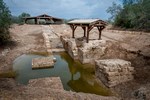 The site of John the Baptist's settlement at Bethany beyond the Jordan, where Jesus was baptized, as mentioned in the Bible (John 1:28) and from the Byzantine and medieval texts. The site has now been identified on the east bank of the Jordan River, in the Hashemite Kingdom of Jordan, and is being systematically surveyed, excavated, restored, and prepared to receive pilgrims and visitors from all over the world.
The site of John the Baptist's settlement at Bethany beyond the Jordan, where Jesus was baptized, as mentioned in the Bible (John 1:28) and from the Byzantine and medieval texts. The site has now been identified on the east bank of the Jordan River, in the Hashemite Kingdom of Jordan, and is being systematically surveyed, excavated, restored, and prepared to receive pilgrims and visitors from all over the world.
Machaerus
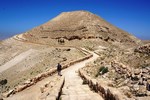 (Qal'atu Mkawer) is a fortified hilltop palace located in Jordan 25 km (16 mi) southeast of the mouth of the Jordan River on the eastern side of the Dead Sea. According to Flavius Josephus, it is the location of the imprisonment and execution of John the Baptist. According to the chronology of the Bible (Mark 6:24; Matthew 14:8), this infamous execution took place in 32 AD following an imprisonment of two years.
(Qal'atu Mkawer) is a fortified hilltop palace located in Jordan 25 km (16 mi) southeast of the mouth of the Jordan River on the eastern side of the Dead Sea. According to Flavius Josephus, it is the location of the imprisonment and execution of John the Baptist. According to the chronology of the Bible (Mark 6:24; Matthew 14:8), this infamous execution took place in 32 AD following an imprisonment of two years.
Aqaba
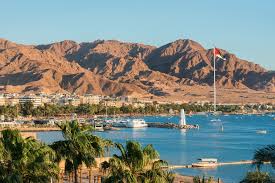 is the only coastal city in Jordan and the largest and most populous city on the Gulf of Aqaba, it is situated in southernmost Jordan. Today, Aqaba plays a major role in the development of the Jordanian economy, through the vibrant trade and tourism sectors. The Port of Aqaba also serves other countries in the region.
is the only coastal city in Jordan and the largest and most populous city on the Gulf of Aqaba, it is situated in southernmost Jordan. Today, Aqaba plays a major role in the development of the Jordanian economy, through the vibrant trade and tourism sectors. The Port of Aqaba also serves other countries in the region.- Aqaba's location next to Wadi Rum and Petra has placed it in Jordan's golden triangle of tourism, which strengthened the city's location on the world map and made it one of the major tourist attractions in Jordan.

 +972-599-446363
+972-599-446363